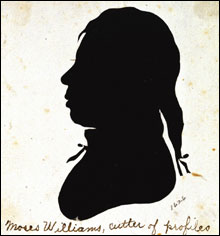Contemporary African-American artists have taken on issues of race and American identity in a wealth of ways, from Kara Walker’s provocative silhouette narratives to Fred Wilson’s discomforting black "collectibles" to William Pope L’s agonizing acts of crawling. A new exhibition at the Addison Gallery of American Art adds depth to our understanding of the establishment and portrayal of racial identity in American history. Curated by art historian Gwendolyn Dubois Shaw, "Portraits of a People: Picturing African Americans in the 19th Century" opens on January 14 with more than 70 portraits made of and by African-Americans from the days of the American Revolution through the Civil War and into the Gilded Age. The works include an early-19th-century silhouette labeled Moses Williams, Cutter of Profiles that’s attributed to artist Raphaelle Peale, son of famed American portra it painter, scientist, and museum proprietor Charles Willson Peale. Moses Williams grew up as the elder Peale’s slave, and he worked as a silhouette cutter in his museum in Philadelphia after being freed in the early 1800s. The silhouette reveals how even this simple form of portraiture offers complex visual cues and clues about the race, gender, and class of its subject. Running concurrently at the Addison, "Young America: The Daguerreotypes of Southworth & Hawes" presents photographs by Albert Sands Southworth (1811–1894) and Josiah Johnson Hawes (1808–1901). The famed duo took portraiture, particularly of the rich and famous, to new technical and artistic levels in their Boston studio between 1843 and 1863.
it painter, scientist, and museum proprietor Charles Willson Peale. Moses Williams grew up as the elder Peale’s slave, and he worked as a silhouette cutter in his museum in Philadelphia after being freed in the early 1800s. The silhouette reveals how even this simple form of portraiture offers complex visual cues and clues about the race, gender, and class of its subject. Running concurrently at the Addison, "Young America: The Daguerreotypes of Southworth & Hawes" presents photographs by Albert Sands Southworth (1811–1894) and Josiah Johnson Hawes (1808–1901). The famed duo took portraiture, particularly of the rich and famous, to new technical and artistic levels in their Boston studio between 1843 and 1863.
The nude has always been a popular subject in art of all sorts, and ever since the birth of photography, artists and amateurs alike have been training their lenses on the unclothed human body. Opening at the Griffin Museum of Photography on January 13, "The Body Familiar: Current Perspectives on the Nude" brings together work by a fine group of artists who push the boundaries of this age-old topic, including the unflinching photographer of his own aging body, John Coplans.

Art finds much of its raison d’être in the idea of authenticity and originality, notions that Boston-based artist Alfredo Conde examines through the lens of our obsession with possessing objects of social status, whether or not they’re real. Opening at the Essex Art Center on January 13, "Alfredo Conde: Objects, Wall Paintings and Works on Paper" re-creates a familiar street scene by displaying fake high-end watches, name-brand sunglasses, and cellphones in open suitcases. But Conde has faked these fakes, challenging us to take a closer look at our consumption-crazed culture.
"Portraits of a People" and "Young America" @ Addison Gallery of American Art, Phillips Academy, Andover | Jan 14–March 14 | 978.749.4015
"The Body Familiar" @ Griffin Museum of Photography, 67 Shore Road, Winchester | Jan 13–March 19 | 781.729.1158
"Alfredo Conde" @ Essex Art Center, 56 Island Street, Lawrence | Jan 13–Feb 24 | 978.685.2343
___
On the Web:
Addison Gallery of American Art at Phillips Academy: http://www.addisongallery.org
Griffin Museum of Photography: http://www.griffinmuseum.org
Essex Art Center: http://www.essexartcenter.com